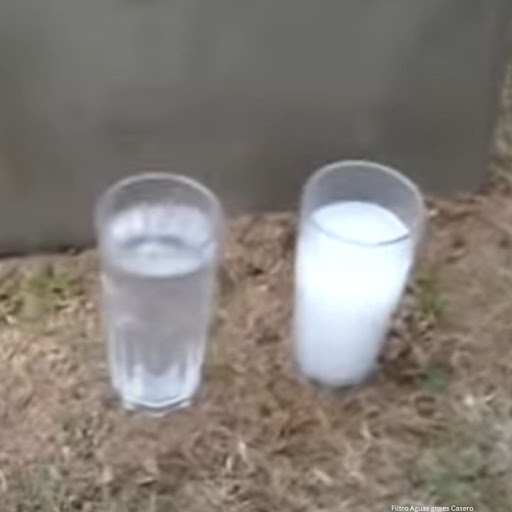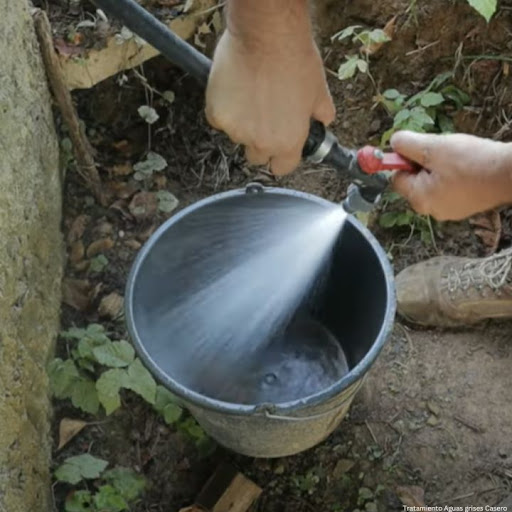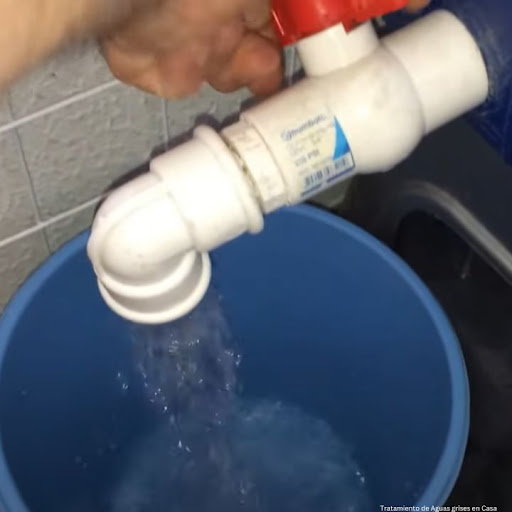Domestic Greywater Treatment
The greywater treatment systems that Pigra Engineering S.L. specialises in are suitable for larger scale cases; but in smaller scale, everyday situations, the home greywater treatment system is a viable alternative to purify and reuse wastewater generated in domestic activities. This process can be done using simple methods and technologies that are within the reach of anyone and do not require sophisticated equipment or facilities.
The following are some common steps for home-based greywater treatment:
- Filtration: The first stage consists of removing suspended solids and larger particles present in the Wastewater. This can be achieved by using home-made filters, such as gravel and sand filters, fine mesh or even nylon stockings. These filters help to retain larger particles and improve water clarity.
- Decanting: After filtration, it is recommended to allow the water to settle in a container large enough for the heavier particles to settle to the bottom. This will facilitate the separation of sediment and will allow for clearer water at the surface.
- Disinfection: Disinfection is a crucial step in eliminating pathogenic micro-organisms present in the Wastewater. There are different home disinfection methods, such as the use of chlorine, iodine, hydrogen peroxide or even exposure to the sun for a prolonged period of time. These methods help to reduce the presence of bacteria, viruses and other harmful organisms.
It is important to note that domestic greywater treatment can vary depending on the resources available and the specific needs of each situation. In addition, it is essential to take precautionary measures to ensure the safety and quality of the treated water. Periodic testing is recommended to evaluate the effectiveness of the treatment and to ensure that the treated water meets the standards required for its intended use.
It is always advisable to research and familiarise yourself with local regulations and water quality standards before implementing a Home Greywater Treatment system. In some cases, it may be necessary to obtain permits or professional advice, such as Pigra Engineering S. L., to ensure safety and compliance with regulations.
In summary, Domestic Greywater Treatment is a feasible option to purify and reuse wastewater in domestic activities. Although homemade methods may be less sophisticated than professional systems, with the right steps it is possible to achieve an improvement in water quality and reduce environmental impact by reusing this valuable resource.


A Homemade Greywater Filter is a practical and economical solution to purify wastewater generated from domestic activities and reuse it safely. This type of filter can be constructed using simple materials that are readily available, making it an affordable option for those who wish to treat and utilise greywater in their homes.
The following is a basic example of how to build a homemade greywater filter:
Materials required:
- A large container, such as a plastic barrel or storage container.
- Coarse gravel.
- Fine sand.
- Small stones or rocks.
- Fine mesh fabric.
- An outlet pipe.
Steps to build the filter:
- Prepare the container: Clean and disinfect the container before starting. Make sure it is free of chemicals or contaminants that may affect water quality.
- Layer of stones: Place a layer of small stones in the bottom of the container. This will help provide a solid base for the filter and allow for proper drainage.
- Gravel layer: Add a layer of coarse gravel on top of the stones. The gravel will help to retain larger particles and improve the filtration process.
- Sand layer: On top of the gravel layer, add a layer of fine sand. The sand will act as an additional filter medium and will help to remove smaller particles and sediments present in the water.
- Mesh layer: Place a fine mesh fabric on top of the sand layer. This mesh will help to retain smaller particles and improve water clarity.
- Outlet pipe: On the side of the container, make a hole and place an outlet pipe to drain the filtered water.
Once the filter is constructed, pour the greywater into the top of the container and allow it to pass through the different layers of filtration. The filtered water will be collected in the container and can be used for garden irrigation, cleaning or other non-drinking applications.
It is important to note that this home filter is a basic solution and does not guarantee complete removal of all contaminants from greywater. Additional steps, such as disinfection by the addition of chlorine or exposure to the sun for a period of time, may be required to ensure the safety of the treated water.
In addition, regular maintenance of the filter, such as cleaning and replacement of the filter layers, is recommended to maintain its effectiveness over time.
In summary, a home greywater filter is an affordable and practical option for purifying wastewater in the home. Although it is important to understand its limitations and take additional precautions, such as disinfection, it can be an effective solution to reuse greywater and reduce drinking water consumption.

The recovery of greywater in a single-family house is an efficient and sustainable approach to harnessing wastewater generated from domestic activities. This process involves collecting, treating and reusing grey water for various purposes, which helps to reduce the consumption of potable water and minimise the load on sewage systems.
Greywater recovery in a single-family house can be carried out in the following steps:
- Collection: Greywater collection systems are installed in the home to collect water from showers, washing machines, toilets and sinks. These systems can be as simple as a collection tank connected to the drains or more sophisticated, such as separate plumbing systems that specifically direct greywater to storage.
- Filtration and Treatment: Once collected, the grey water undergoes a filtration and treatment process to remove impurities and contaminants. This may include the removal of solid particles by gravel and sand filters, as well as disinfection by methods such as chlorination or the use of ultraviolet light systems. Treatment is adapted to the needs and resources of each home, ensuring a quality suitable for reuse.
- Storage and distribution: Treated Greywater is stored in dedicated tanks and distributed for reuse in various non-potable applications. It can be used for watering gardens and green areas, cleaning floors and surfaces, or even flushing toilets. Adequate plumbing systems are used to direct and control the flow of treated greywater to the different areas of use.
Greywater reclamation in a single-family house has numerous benefits. Some of these include:
- Drinking water savings: By reusing grey water, dependence on drinking water supply for non-potable uses, such as irrigation or cleaning, is reduced. This contributes to saving fresh water and helps to preserve this valuable resource.
- Reduced load on sewerage systems: By diverting greywater from the sewerage network, the load on wastewater treatment plants is reduced and the costs associated with the transport and treatment of large volumes of water are lowered.
- Efficient use of resources: By reusing greywater, the nutrients and organic components present in the greywater are utilised, which can contribute to improving soil fertility in the case of garden irrigation. This promotes more efficient resource management and reduces the need for chemical fertilisers.
It is important to note that the implementation of greywater reclamation in a single-family house requires proper design and regular maintenance. In addition, local regulations and standards must be followed to ensure the safety and quality of the treated water.
In summary, greywater reclamation in a single-family house is a sustainable practice that allows wastewater to be reused for non-drinking purposes. With the right Collection, Filtration and Treatment systems, efficient use of water resources can be achieved and contribute to the conservation of drinking water and the care of the environment.


The domestic wastewater treatment is a fundamental process to ensure public health, protect the environment and promote the sustainable use of water. It consists of a series of steps and technologies to remove pollutants and improve water quality before discharge into the environment.
The main steps involved in Domestic Wastewater Treatment are described below:
- Pretreatment: In this stage, activities are carried out to remove large solids and non-biodegradable materials present in the wastewater. This includes the use of grids and grease traps to retain objects and substances that could clog the treatment systems.
- Primary treatment: In this phase, the wastewater is subjected to a sedimentation and/or flotation process to separate settleable and floating solids. A settler or clarifier is used to allow heavier particles to settle to the bottom and floating materials to be removed at the surface. This helps to reduce the load of suspended solids and grease in the water.
- Biological treatment: After primary treatment, the wastewater is directed to a biological treatment process. Here, aerobic or anaerobic microorganisms break down and metabolise the organic matter present in the water. The most common systems are sequential biological reactors (BBRs) and activated sludge, which use bacteria and other micro-organisms to remove organic pollutants.
- Advanced treatment: In some cases, depending on local requirements and desired water quality, additional treatment may be applied to remove specific contaminants. These may include filtration processes, disinfection by chlorination or ultraviolet disinfection, and removal of nutrients such as nitrogen and phosphorus.
- Disinfection: As the final stage of treatment, the treated wastewater is disinfected to eliminate pathogenic micro-organisms and ensure its safety before release into the environment. This can be achieved through the use of disinfectant chemicals, such as chlorine, or through technologies such as ultraviolet radiation.
It is important to note that the treatment of domestic wastewater can vary depending on factors such as the capacity of the treatment plant, local regulations and the characteristics of the wastewater. In addition, regular monitoring and proper maintenance of treatment systems is essential to ensure their efficiency and to meet water quality standards.
Domestic wastewater treatment is essential to protect public health and the environment. Contributes to the conservation of water resources and reduces the negative impact of untreated wastewater discharge. By implementing appropriate treatment systems, we can ensure the availability of clean water and preserve the health of communities and ecosystems.


A Greywater Biofilter is an efficient and sustainable technology used in domestic wastewater treatment. This system is based on the use of micro-organisms and biological processes to break down and remove pollutants in grey water, allowing it to be reused in a safe and environmentally friendly way.
The operation of a greywater biofilter is based on the following principles:
- Filter media: The biofilter uses filter media such as gravel, sand, activated carbon or specific biomaterials to create an environment conducive to the growth of beneficial micro-organisms. These media provide an adhesion and retention surface for micro-organisms, allowing them to carry out their task of decomposing contaminants.
- Biological processes: The micro-organisms present in the biofilter, such as bacteria and fungi, feed on the organic matter and pollutants present in the grey water. As the water passes through the biofilter, microorganisms break down organic compounds, reducing the pollutant load and improving water quality.
- Oxygenation: To ensure optimal functioning of the micro-organisms, the biofilter needs an adequate supply of oxygen. This is achieved through system design that allows for adequate aeration of the water, either through air circulation or the incorporation of oxygenation mechanisms.
- Maintenance and monitoring: To ensure the effectiveness of the biofilter, regular maintenance is required. This may include cleaning the filter media to remove accumulated solids and controlling the population of micro-organisms to maintain a proper balance.
Greywater biofilters offer several advantages compared to other treatment technologies. Some of the benefits are:
- Efficiency in the elimination of pollutants: The microorganisms present in the biofilter are highly effective in breaking down organic compounds, fats, oils, grease and other pollutants present in the grey water.
- Low energy consumption: Biofilters do not require the use of additional energy, as the biological processes take place naturally.
- Low cost of operation and maintenance: The materials used in biofilters are generally affordable and inexpensive, and maintenance is relatively simple compared to other treatment systems.
- Safe water reuse: After passing through the biofilter, the treated grey water can be used for garden irrigation, car washing and other non-drinking applications, which contributes to saving drinking water.
It is important to note that the implementation of a greywater biofilter requires proper design and careful operation to ensure its proper functioning and the quality of the treated water. It is also essential to comply with local regulations and standards to ensure safety and environmental protection.
In summary, a greywater biofilter is a natural and effective technology for domestic wastewater treatment. By harnessing biological processes, this system enables the safe reuse of greywater, promoting the conservation of water resources and contributing to a more sustainable approach to water management.

The domestic greywater is the wastewater generated from daily activities within a household. This water comes from cooking, bathing, laundry and other domestic areas and contains a variety of pollutants and organic matter.
Greywater differs from blackwater, which is water from toilets and contains high levels of faecal matter and pathogens. Greywater, on the other hand, generally has lower levels of biological contaminants and can be safely treated and reused for certain purposes.
Some examples of domestic greywater include:
- Hand washing and shower water: Water used for hand washing and showering is a common source of greywater. Although it may contain small amounts of soap and personal care products, it generally does not present a high risk of contamination.
- Washing machine water: Water used to wash clothes in a washing machine is also considered greywater. It may contain traces of detergent and dirt particles, but with proper treatment, it can be reused in applications such as garden irrigation.
- Sink water: Water used in the kitchen sink, where dishes and utensils are washed, is also classified as greywater. May contain food and grease residues, which require further treatment before reuse.
The reuse of domestic greywater offers several benefits.
Some of them are:
- Drinking Water Savings: By reusing greywater, dependence on drinking water supply for non-potable uses, such as irrigation or cleaning, is reduced. This contributes to saving fresh water and helps to preserve this valuable resource.
- Reduced load on sewerage systems: By diverting greywater from sewerage systems, the load on wastewater treatment plants is reduced and the costs associated with transporting and treating large volumes of water are reduced.
- Efficient use of resources: By reusing greywater, the nutrients and organic components present in the greywater are utilised, which can contribute to improving soil fertility in the case of garden irrigation. This promotes more efficient resource management and reduces the need for chemical fertilisers.
It is important to note that proper treatment of domestic greywater is essential before reuse. This may involve the implementation of appropriate filtration, disinfection and storage systems to ensure the quality of the treated water.
In conclusion, domestic greywater represents a potentially reusable source of water, which can help reduce potable water consumption and minimise the load on sewerage systems. By implementing appropriate Treatment and Reuse practices, we can make responsible use of this resource and promote sustainable water management in our homes.

Glossary:
- Domestic Greywater Treatment
- Homemade Greywater Filter
- Grey water recovery Single-family house
- Domestic wastewater treatment
- Greywater Biofilter
- Domestic greywater
- Greywater Treatment at Home
- Greywater Filter
- Reuse Greywater Home
